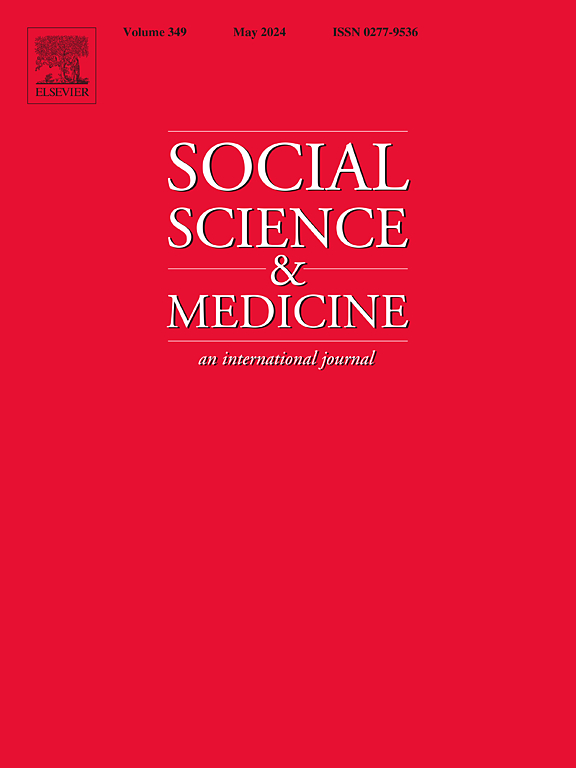“Can you bury him before he dies?” Sickle cell disease and social sites of suffering in Malawi and Uganda
IF 5
2区 医学
Q1 PUBLIC, ENVIRONMENTAL & OCCUPATIONAL HEALTH
引用次数: 0
Abstract
In health-related research, experience of illness is commonly characterised by its physical signs and symptoms. However, the experience of illness also extends past the patients' bodily aches and ailments to influence, and possibly impair, their social interactions. Despite its relational ramifications, the field of medicine has not awarded enough attention towards social dimensions of suffering nor the ways in which chronic disease may change and constrain the tapestries of social life. During everyday encounters, ill individuals are often subjected to the objectifying, evaluative gaze of healthy onlookers, who view them from a detached, third-person perspective. This paper explores interpretations of illness in the context of the genetic blood disorder sickle cell disease in Uganda and Malawi. 11 focus group discussions were held with children above 10 years of age with sickle cell disease, while 18 discussions were performed with caregivers of children with sickle cell disease. Drawing on this data, we describe how social interplay between sickle cell ‘sufferers’, their caregivers, and surrounding ‘spectators’ was coloured by community discourses on death, misconceptions about contagiousness, and attribution of perceived deviance. Beyond clinical features of pain and pathology, sickle cell suffering would take on socially situated forms where the ideas and imageries of ‘observing others’ led to added agony and alienation among affected individuals and their intimates. When addressing the predicament of patients and their families, one should consider how the medical meaning-making and opinions of others may give rise to what we herein refer to as ‘social sites of suffering’.
“你能在他死之前把他埋了吗?”镰状细胞病和马拉维和乌干达遭受苦难的社会场所。
在与健康有关的研究中,疾病经历通常以其身体体征和症状为特征。然而,疾病的经历也超越了病人的身体疼痛和疾病,影响并可能损害他们的社会交往。尽管有相关的影响,但医学领域对痛苦的社会层面以及慢性病可能改变和限制社会生活的方式没有给予足够的重视。在日常接触中,生病的人经常受到健康的旁观者物化的、评价性的目光,这些旁观者以超然的第三人称视角看待他们。本文探讨了在乌干达和马拉维遗传血液疾病镰状细胞病的背景下对疾病的解释。与10岁以上患有镰状细胞病的儿童进行了11次焦点小组讨论,与镰状细胞病儿童的照料者进行了18次讨论。根据这些数据,我们描述了镰状细胞“患者”、他们的照顾者和周围“旁观者”之间的社会相互作用是如何被社区关于死亡的话语、对传染性的误解和感知偏差的归因所影响的。除了疼痛和病理的临床特征之外,镰状细胞的痛苦还会以社会地位的形式出现,在这种形式下,“观察他人”的想法和形象会导致受影响的个人及其亲密关系之间增加痛苦和疏远。在处理病人及其家属的困境时,人们应该考虑他人的医学意义和意见是如何产生我们在这里所说的“痛苦的社会场所”的。
本文章由计算机程序翻译,如有差异,请以英文原文为准。
求助全文
约1分钟内获得全文
求助全文
来源期刊

Social Science & Medicine
PUBLIC, ENVIRONMENTAL & OCCUPATIONAL HEALTH-
CiteScore
9.10
自引率
5.60%
发文量
762
审稿时长
38 days
期刊介绍:
Social Science & Medicine provides an international and interdisciplinary forum for the dissemination of social science research on health. We publish original research articles (both empirical and theoretical), reviews, position papers and commentaries on health issues, to inform current research, policy and practice in all areas of common interest to social scientists, health practitioners, and policy makers. The journal publishes material relevant to any aspect of health from a wide range of social science disciplines (anthropology, economics, epidemiology, geography, policy, psychology, and sociology), and material relevant to the social sciences from any of the professions concerned with physical and mental health, health care, clinical practice, and health policy and organization. We encourage material which is of general interest to an international readership.
 求助内容:
求助内容: 应助结果提醒方式:
应助结果提醒方式:


